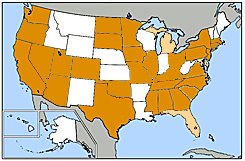Redmond, OR
I have never been so lost. A few nights ago, after sitting on the tarmac for a couple of hours in Scranton, PA (nope, didn’t see Jim or Dwight or anyone else), we finally landed in White Plains, NY (they had to shovel off the runway.) I waited another half an hour for the car rental person to appear behind the desk, scraped off my windshield, and headed out into the night armed with the MapQuest directions that Andy always attaches to my trip info. I’d finally be at my hotel in a just a few short minutes.
It ended up being over an hour.
The first problem was that the MapQuest directions were worthless. This is actually fairly common, as street signs are not always accurate or readable (or present), there’s construction, traffic, roads don’t actually exist, etc. But this time it was worse: Andy didn’t have the correct starting address, it was just the geographic center

of the zip code!
“No problem, I’ll just use the map that came with the rental car.” Except it was of the entire state of New York, which didn’t help me much.
“Okay, I’ll just head south and I’ll run into a populated area, and find it from there.” (I wasn’t actually talking to myself, by the way. That came later, mostly in the form of four letter words.) Unfortunately, there wasn’t really a populated area; it was all just large estates and corporate campuses. It was after 10pm, foggy, snowy, and there wasn’t a soul to be seen. Even I was considering asking for help if I could find someone!
As I toured randomly around rural roads, strange merging “expressways,” and icy driveways, I thought of how we teach kids to solve problems. It’s a lot like trying to get to a destination, and there are multiple ways to approach it. Last spring, I had developed this “diamond of knowing” (or as one new colleague refers to it: The Geisometer.) I’ve drawn myself on there as an example.

In trying to solve my current problem, I’d hoped that the factual would be enough (the MapQuest directions.) But as is often the case, real life problems don’t always fit nicely in to neat packages or formulas. Normally, I would rely on my analytical skills to navigate places quickly (my friends refer to me as “MapMan!” for this reason.) But the map was woefully inadequate.
I have a colleague and friend in Japan who never uses a map or directions, Keiko uses an approach that is very practical on the streets of Tokyo: she simply asks people how to get everywhere. This works great for her, but wasn’t an option for me this night.
This left me to simply explore creatively to create my own mental map of the area. Not the quickest way to get places, but you really learn the area and find things that you normally wouldn’t find. I generally prefer this approach (combined with a basic map), but not after 12 hours of traveling, while in the fog and snow, and on a very empty stomach. (see my NYC video for more on this analogy.)
I eventually turned to technology, and using the map feature on my BlackBerry (which showed a not very helpful jumble of overlapping roads), the Google directions feature (it took me quite a while to figure out an address to use for a start location), and a bit of luck, I finally made it to my hotel. I’m sure there were other solutions, but in my fatigued, hungry, confused state it just wasn’t happenin’.
In the current version of education, we’re focusing heavily on MapQuest directions and a little bit of map analysis, but rarely do kids get a chance to explore more practical and creative solutions. When we need to reach a goal quickly, it’s easiest to just say “here, follow these directions.” Unfortunately, life isn’t always so tidy. And students need to know more than just how to get from point A to point B. They need to get familiar with the whole intellectual landscape.
A combination of all approaches is needed, and balancing them is the job of the professional educator.



























